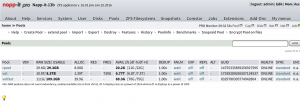The Future of OmniOS
Quelle: [OmniOS-discuss] The Future of OmniOS
Was wird die Zukunft von OmniOS bringen? Offensichtlich wird es für OmniOD kritisch. Nexenta Stor und viele andere Firmen setzen auf auf Illumos also wird es mit ZFS Storage Lösungen weiter gehen.
Sollte man vieleicht auf SmartOS oder Nexenta Community gehen? Oder gar das Orginal, Solaris pur? – stay tuned 😉

